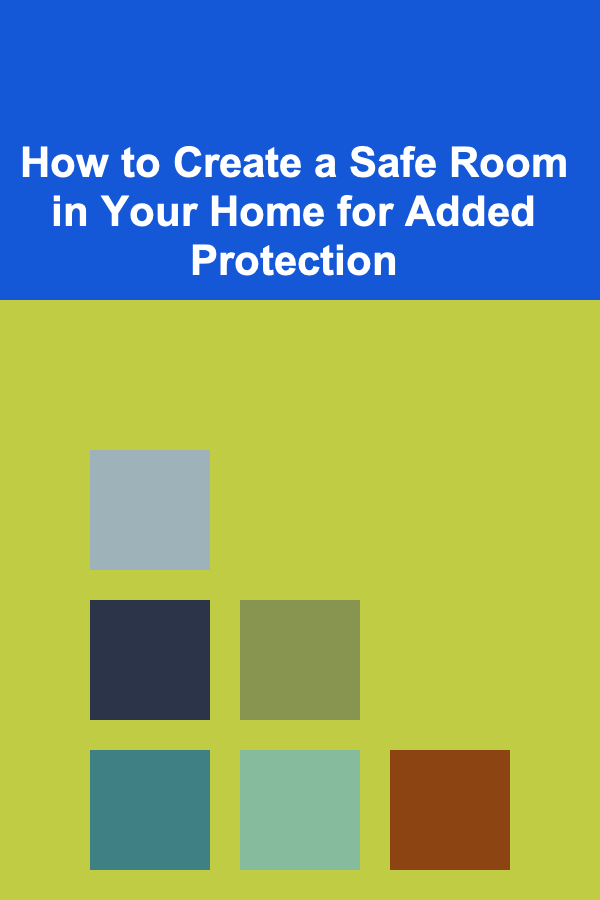
How to Create a Safe Room in Your Home for Added Protection
ebook include PDF & Audio bundle (Micro Guide)
$12.99$11.99
Limited Time Offer! Order within the next:

A safe room, also known as a panic room, is a secure space within your home that provides protection during emergencies. It's a place where you and your loved ones can retreat if there's a break-in, natural disaster, or other life-threatening situation. While the concept of a safe room might evoke images of luxury homes or high-profile individuals, the reality is that any homeowner can benefit from creating a safe room. Whether it's for protection against burglars, home invasions, or extreme weather, a well-designed safe room can provide the peace of mind you need to feel secure in your own home.
This article will explore the various elements that go into creating a safe room in your home, the materials and features to consider, how to design the room for different needs, and the legal and practical aspects of installation. By the end, you'll understand how to build a safe room that suits your family's needs, enhances your home's security, and gives you confidence in your home's safety.
What is a Safe Room?
A safe room is a fortified area in your home where you can retreat to in times of danger. It is designed to offer a high level of security and protection, preventing intruders from accessing the room and offering safety from various hazards, including home invasions, natural disasters, and even civil unrest.
Safe rooms are equipped with reinforced doors, secure locking mechanisms, and often have communication tools, such as a landline phone or two-way radios, so you can contact emergency services if needed. Some safe rooms are simple and functional, while others may include luxuries like a bed, bathroom, and provisions for long-term stays.
The purpose of a safe room is to give the occupants enough time to survive a threatening situation until help arrives or the danger subsides. In many cases, a safe room is built to withstand intruders, providing a buffer zone between your family and a potential threat.
Types of Safe Rooms
- Panic Room: A panic room is often a small, highly fortified space designed for short-term protection during a crisis, such as a home invasion. It generally includes essential survival supplies and secure communication tools.
- Storm Shelter: A safe room designed to protect against natural disasters like tornadoes, hurricanes, or earthquakes. These rooms are often reinforced to withstand high winds and flying debris.
- Vault Room: A room designed to protect valuable items and keep them secure in the event of a break-in. While it may not be used as a refuge for people, it still serves as a safe and secure room.
- Safe Room for Family Safety: A multi-purpose room where you can protect your entire family from both human threats and natural disasters. These rooms often feature reinforced walls, ventilation systems, and emergency supplies.
Why Should You Build a Safe Room?
Having a safe room in your home offers several benefits. While not all situations will necessitate the use of a safe room, it provides an added layer of protection in case of emergencies. Here are some reasons why you might consider building a safe room in your home:
2.1 Protection Against Home Invasions
Home burglaries are unfortunately a common crime, and in some cases, intruders may break into your home while you're inside. A safe room provides a safe haven where you can wait for help and ensure that you and your loved ones are protected from harm.
In addition to keeping you safe, a well-designed safe room can also buy you precious time in the event of a break-in. If the intruders are unable to access the room, they may leave the house, giving you a chance to contact authorities.
2.2 Natural Disasters
Severe weather events like tornadoes, hurricanes, and earthquakes can pose significant risks to homeowners, particularly in regions prone to such disasters. A safe room can be designed to withstand these events, keeping you safe from debris, high winds, and other dangers.
For example, storm shelters are built with reinforced concrete walls and ceilings, making them capable of withstanding extreme weather conditions. In addition, these rooms can be equipped with provisions such as food, water, and medical supplies in case of prolonged confinement.
2.3 Civil Unrest
In times of civil unrest or social instability, having a designated safe space within your home can be critical. Whether it's the threat of riots, violent protests, or civil disobedience, a safe room can provide you with the security and isolation needed until the danger passes.
2.4 Peace of Mind
Creating a safe room can also give you peace of mind. Knowing that you have a secure place to retreat to in case of danger can alleviate anxiety and provide a sense of security for you and your family. This peace of mind is invaluable, especially for families who may be particularly vulnerable or worried about safety.
Choosing the Right Location for Your Safe Room
The first step in creating a safe room is selecting the right location in your home. There are a few key considerations to keep in mind when choosing the ideal spot:
3.1 Accessibility
The safe room should be easily accessible, particularly if there is a crisis occurring in your home. You don't want the room to be difficult to reach, especially during a time when every second counts. It should be centrally located, preferably on the ground floor or below, so that it can be reached quickly.
3.2 Seclusion
The room should be hidden enough that intruders will have difficulty finding it. Ideally, it should not be located near windows or easily visible areas. Some people choose to build their safe room in a basement, closet, or an interior room, as these areas are often the hardest to access.
3.3 Reinforcement Potential
You want a space that can be easily reinforced with materials like steel or reinforced concrete. Choose a room with no exterior windows, as these can provide a point of entry for intruders. The walls and door should be capable of withstanding force.
3.4 Space for Supplies
Your safe room should be large enough to accommodate all the people you want to shelter, along with supplies such as food, water, medical kits, and communication devices.
Designing Your Safe Room
Once you've chosen the right location, it's time to design your safe room. Below are the key elements to consider when designing a room that will provide maximum protection:
4.1 Walls and Doors
The walls and doors of your safe room must be reinforced to provide protection against forced entry, gunfire, and natural disasters. Strong materials like steel, reinforced concrete, or ballistic-rated panels can be used for this purpose.
The door should be made of solid steel and equipped with heavy-duty locking mechanisms. It is also crucial that the door opens inward (instead of outward) to prevent someone from forcing it open from the outside.
4.2 Ventilation
Ventilation is an important consideration, especially if you plan on using the safe room for an extended period. While it's important to keep the room secure, you don't want it to be completely sealed, as this could cause suffocation or make it difficult to breathe over time.
Installing an air filtration system or ventilation ducts will allow air to circulate, ensuring you have a fresh supply of oxygen. Some homeowners opt for a system that is designed to withstand chemical, biological, or radioactive threats.
4.3 Communication Tools
Communication tools are essential in a safe room, especially if you need to call for help or receive updates. A landline phone is often recommended, as cell phone signals may be blocked or unreliable during a crisis.
Two-way radios or satellite phones are also valuable alternatives for communication in an emergency. These devices can work even if the regular phone network is down.
4.4 Safety Supplies
Your safe room should be stocked with essential supplies to ensure you can survive for an extended period. These supplies might include:
- Water: Store enough water for each person to have one gallon per day for at least three days.
- Food: Non-perishable food items such as canned goods, protein bars, and dried fruit.
- First Aid Kit: A well-stocked first aid kit to address medical emergencies.
- Flashlights and Batteries: Power outages are common during emergencies, so have plenty of flashlights and extra batteries.
- Fire Extinguisher: A small fire extinguisher in case of a fire emergency.
4.5 Security Features
You may also want to install a few additional security features to enhance the room's protection. Some of these features include:
- Surveillance cameras: Install cameras around your property to monitor for intruders. Ensure they have a backup power source.
- Alarms: Integrate alarms to alert you to any breaches or intrusions.
- Bulletproof Glass: If you need windows in your safe room, consider using bulletproof or shatter-resistant glass to prevent someone from breaking in.
Building the Safe Room
The construction of a safe room is a serious undertaking that requires professional expertise. If you have the necessary skills, you can attempt a DIY project, but for most people, it's best to hire a contractor with experience in building secure rooms.
5.1 Budgeting for Your Safe Room
The cost of building a safe room can vary significantly based on the materials used, the size of the room, and the level of security you want to incorporate. Expect to pay anywhere from a few thousand dollars for a basic safe room to tens of thousands for a highly secure, multi-functional space.
5.2 Hiring Professionals
Hiring an architect or contractor with experience in safe room construction is crucial for ensuring that your room is built to the highest standards. They can help you with the structural integrity, material selection, and installation of various features, including security systems and ventilation.
5.3 Legal Considerations
Before building your safe room, it's essential to check local building codes and regulations. Some regions have restrictions on the types of materials you can use or the construction methods you can apply. Make sure your safe room complies with all local laws.
Conclusion
Building a safe room in your home is one of the most proactive steps you can take to protect your family from a variety of threats. Whether you are concerned about break-ins, natural disasters, or civil unrest, a safe room offers an added layer of security and peace of mind. By carefully choosing the right location, designing the room for maximum protection, and incorporating essential security features, you can create a space that will provide safety and protection when you need it the most.

How to Choose the Perfect Playlist for Your Party's Vibe
Read More
How to Create a Solid Marketing Strategy for Your Rental
Read More
How to Remove Stubborn Stains from Your Upholstery
Read More
How to Stage Your Home for the Spring or Summer Market
Read More
How To Evaluate a Film's Philosophical Themes
Read More
How to Choose the Right Arrow Spine for Your Bow
Read MoreOther Products

How to Choose the Perfect Playlist for Your Party's Vibe
Read More
How to Create a Solid Marketing Strategy for Your Rental
Read More
How to Remove Stubborn Stains from Your Upholstery
Read More
How to Stage Your Home for the Spring or Summer Market
Read More
How To Evaluate a Film's Philosophical Themes
Read More